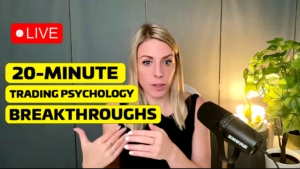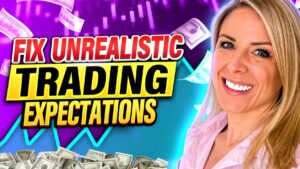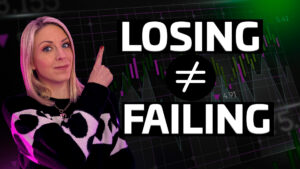Profit is the bottom line performance metric in trading.
So, once you have a solid trading strategy and have experienced some success in the market, it’s natural to aim for bigger returns.
At this point, most traders try scaling up by increasing position size, trading more contracts or diversifying strategies.
However, scaling up increases pressure—and with it, weaknesses in your trading psychology.
Problems like fear of missing out (FOMO), impulsive trades, and broken rules become more prevalent and costly.
To mitigate these risks, you need a sharp mental edge and a strategic approach to scaling up.
In this blog post, I’ll share a simple framework to ensure you psychology is robust and ready for the pressures of scaling up—no matter whether you are going from sim to live trading or taking the leap from 60 to 80 contracts.
Before we jump in I just need to caveat that this framework assumes three things:
- You already have a solid trading strategy that is theoretically profitable
- You have good technical skill
- You have the mental training tools at your disposal to strengthen your mental edge
If you haven’t yet achieved those milestones I would encourage you to work on those first before tackling this framework or attempting to scale up.
And if you need help with optimising your trading mental edge, check out my Free Trading Psychology Masterclass for a proven system to build unbreakable trading psychology.
Knowing When to Scale Up
For many traders, the decision of when to scale up is based on emotional factors—impatience with your rate of progress, fear of missing out, greed or even comparison with other traders.
Let’s use the analogy of building a mansion.
To build a solid mansion, you have to pour the foundations first. But you look at your neighbour next door who is also building a mansion and you see theirs is going up quicker than yours and you feel you really should be further ahead with your own schedule.
You skim through the foundation setting and jump straight to phase 3 of building the mansion—trying to build the third floor and decorate it with the most stylish furnishings…
You are building a house that will inevitably crumble down around you—you are setting yourself up for failure.
It’s the same with scaling up in trading— if you rush through the process of scaling up and try to move to a higher level before you are psychologically ready, this will have catastrophic consequences for your account.
The best way to determine how, when and by how much to scale up, is to completely unplug from emotion and adopt a logical, systematic approach.
In the same way as prop firms set out very clear criteria as to what determines passing a tryout and earning a funded account, you can create a similar system for yourself to take some of the risk out of scaling up.
Phased Approach to Scaling Up Without Blowing Up
Here are the 3 steps to creating your own performance-based framework for successfully scaling up:
#1. Identify your baseline.
List out how you are trading currently—your current risk-reward ratio, position sizing, how many contracts you are trading with, whether you are trading on sim or live etc.
This gives you the baseline criteria from which you can then plan to scale.
#2. Map out each phase of your plan for scaling up.
Think of scaling up like a set of stairs—each step is a new phase. You may want to reach an entirely different level in your trading but the pathway to getting there is by taking small, incrementally more challenging steps.
I suggest starting with planning the next four phases. For each phase, decide what the new position sizing or number of contracts will be.
Crucially, nothing fundamental about your strategy or the markets you are trading in will change with each phase.
You are just incrementally increasing the level of pressure and risk that you are taking in the market in order to see slightly higher returns at each juncture.
#3. Identify the concrete milestones you need to hit in order to pass each phase.
The phased approach to scaling up is based on hitting performance goals, rather than time in the market. This helps you remove emotion and comparison from your decision-making.
Map out specific “passing criteria” that you need to hit in order to progress to the next phase.
You can include a minimum timeframe of consecutive weeks in which you need to consistently hit your goals, but moving to the next phase does not automatically happen when this timeframe expires—only if your goals are achieved.
These goals should reflect success in both your process (discipline in the execution of your trading plan) and profitability (PNL). So for example “sticking to my daily loss limit on 100% of days, 85% or higher of all trades taken met my A+ setup criteria, and consistently profitable over a specified period of time (e.g. a 6-week period)”.
As risk increases, performance needs to correspondingly improve.
Example Scenario
Let’s take the example of someone who is currently trading on sim with 20 micro contracts on the NQ.
Phase 1
- Baseline Criteria: 20 micro contracts trading on NQ on sim
- Passing Criteria: Achieve 4 “green” process and green PNL weeks in a row before moving to phase 2.
Phase 2
- Criteria: 20 micro contracts trading on NQ live
- Passing Criteria: Achieve at least 9 weeks out of 12 consecutive weeks of hitting my process and PNL goals before moving to phase 3.
Phase 3
- Criteria: 3 mini contracts trading on NQ live
- Passing Criteria: Achieve at least 10 weeks out of 12 consecutive weeks of hitting my process and PNL goals before moving to phase 4.
Phase 4
- Criteria: 4 mini contracts trading on NQ live
- Passing Criteria: Achieve at least 13 weeks out of 16 consecutive weeks of hitting my process and PNL goals before moving to phase 5.
Three Tips for Successful Scaling
To get maximum value from this framework for your trading, consider these three important tips:
1. Make sure your psychology is robust in each phase before progressing to the next one.
If you are hitting your goals but still seeing problems like revenge trading, ignoring loss limits or moving stops in your trading, iron these out before moving to the next phase.
2. Don’t make too big a jump at any one time.
You wouldn’t try jump from lifting a 10kg weight to a 100kg in weight in the gym within one week—the same principle applies here. Smaller increases in pressure and expectations will help you build your psychological resilience for long-term success.
3. Be prepared to move down the phases if needed.
If you see that your psychology has become shaky as you move to a new phase, you may want to move back to the previous phase to give yourself an opportunity to troubleshoot and resolve what is going wrong.
Whether it’s personal stress, a change in market conditions or a technical adjustment that is required in your strategy, minimising pressure while working through the issue is the best way to preserve your trading account and keep momentum going strong.
If you enjoyed this article and found it helpful, consider sharing it with other traders who could also benefit from having a phased approach to scaling up.
Three Ways I Can Help You Master Your Trading Psychology
Want to learn more?
- Join The Trading Psychology Masterclass (Free): Join my FREE masterclass to learn the secrets to overcome some of the most common trading psychology challenges that hold traders back from reaching consistent profitability. Plus get two FREE bonuses to help you apply the insights covered in the masterclass to your trading for maximum impact.
- Enrol in Go Deep to Level Up Your Trading™: This is my signature Trading Psychology Program to help you permanently end destructive trading habits and reach pro-level consistency in as little as 8 weeks.
- Unbreakable Trading Psychology —The Book. Join the waitlist for my upcoming book: Unbreakable Trading Psychology: The Seven Principle Playbook for Building a Razor-Sharp Mental Edge. Launching in 2025.










